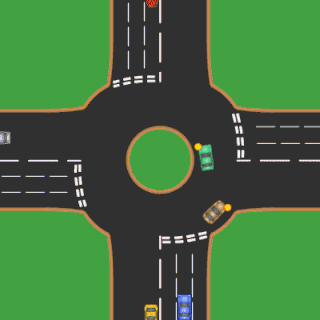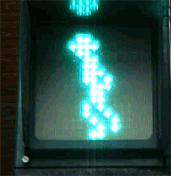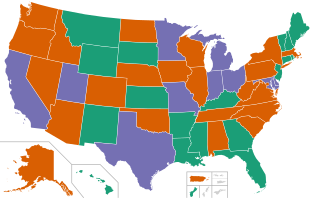
A light-emitting diode (LED) is a semiconductor light source that emits light when current flows through it. Electrons in the semiconductor recombine with electron holes, releasing energy in the form of photons. The color of the light is determined by the energy required for electrons to cross the band gap of the semiconductor. White light is obtained by using multiple semiconductors or a layer of light-emitting phosphor on the semiconductor device.

A roundabout is a type of circular intersection or junction in which road traffic is permitted to flow in one direction around a central island, and priority is typically given to traffic already in the junction.

Electroluminescence (EL) is an optical phenomenon and electrical phenomenon in which a material emits light in response to the passage of an electric current or to a strong electric field. This is distinct from black body light emission resulting from heat (incandescence), a chemical reaction (chemiluminescence), sound (sonoluminescence), or other mechanical action (mechanoluminescence).

An intersection or an at-grade junction is an junction where two or more roads converge, diverge, meet or cross at the same height, as opposed to an interchange, which uses bridges or tunnels to separate different roads. Major intersections are often delineated by gores and may be classified by road segments, traffic controls and lane design.

A pedestrian crossing or crosswalk is a place designated for pedestrians to cross a road, street or avenue. The term "pedestrian crossing" is also used in some international treaties that pertain to road traffic and road signs, such as the Vienna Convention on Road Traffic and the Vienna Convention on Road Signs and Signals.

Traffic lights, traffic signals or stoplights, also known as robots in South Africa, are signalling devices positioned at road intersections, pedestrian crossings, and other locations to control flows of traffic.

Jaywalking is a term, originating in the United States, for pedestrians walking in or crossing a roadway that has traffic, other than at a suitable crossing point, or otherwise in disregard of traffic rules. The term originated with jay-drivers, people who drove horse-drawn carriages and automobiles on the wrong side of the road, before taking its current meaning.

A school bus is a type of bus owned, leased, contracted to, or operated by a school or school district. It is regularly used to transport students to and from school or school-related activities, but not including a charter bus or transit bus. Various configurations of school buses are used worldwide; the most iconic examples are the yellow school buses of the United States and Canada which are also found in other parts of the world.

The lighting system of a motor vehicle consists of lighting and signalling devices mounted or integrated at the front, rear, sides, and in some cases the top of a motor vehicle. They illuminate the roadway ahead for the driver and increase the vehicle's visibility, allowing other drivers and pedestrians to see its presence, position, size, and direction of travel, and its driver's intentions. Emergency vehicles usually have distinctive lighting equipment to warn drivers and indicate priority of movement in traffic.
Signal timing is the technique which traffic engineers use to distribute right-of-way at a signalized intersection. The process includes selecting appropriate values for timing, which are implemented in specialized traffic signal controllers. Signal timing involves deciding how much green time the traffic signal provides an intersection by movement or approach, how long the pedestrian WALK signal should be, whether trains or buses should be prioritized, and numerous other factors.

Solid-state lighting (SSL) is a type of lighting that uses semiconductor light-emitting diodes (LEDs), organic light-emitting diodes (OLED), or polymer light-emitting diodes (PLED) as sources of illumination rather than electrical filaments, plasma, or gas.
A junction is where two or more roads meet.
Traffic signal preemption is a type of system that allows the normal operation of traffic lights to be preempted. The most common use of these systems is to manipulate traffic signals in the path of an emergency vehicle, halting conflicting traffic and allowing the emergency vehicle right-of-way, to help reduce response times and enhance traffic safety. Signal preemption can also be used by light-rail and bus rapid transit systems to allow public transportation priority access through intersections, or by railroad systems at crossings to prevent collisions.

In traffic engineering, there are regional and national variations in traffic light operation. This may be in the standard traffic light sequence or by the use of special signals.

A radar speed sign is an interactive sign, generally constructed of a series of LEDs, that displays vehicle speed as motorists approach. The purpose of radar speed signs is to slow cars down by making drivers aware when they are driving at speeds above the posted limits. They are used as a traffic calming device in addition to or instead of physical devices such as speed bumps and rumble strips.

Xiaolüren can refer to any pedestrian traffic lights, but most often the animated traffic light system originally from Republic of China. It was first implemented in Taipei City between Songshou Road and Songzhi Road, in 1999, and came into widespread use around the country and almost replaced incandescent, static and non-animated pedestrian traffic lights within a few years.

A HAWK beacon is a traffic control device used to stop road traffic and allow pedestrians to cross safely. It is officially known as a Pedestrian Hybrid Beacon (PHB). The purpose of a HAWK beacon is to allow protected pedestrian crossings, stopping road traffic only as needed. The HAWK beacon is a type of traffic control alternative to traffic control signals.

The normal function of traffic lights requires more than sight control and coordination to ensure that traffic and pedestrians move as smoothly, and safely as possible. A variety of different control systems are used to accomplish this, ranging from simple clockwork mechanisms to sophisticated computerized control and coordination systems that self-adjust to minimize delay to people using the junction.

In the United States, road signs are, for the most part, standardized by federal regulations, most notably in the Manual on Uniform Traffic Control Devices (MUTCD) and its companion volume the Standard Highway Signs (SHS).
Road traffic control devices are markers, signs and signal devices used to inform, guide and control traffic, including pedestrians, motor vehicle drivers and bicyclists. These devices are usually placed adjacent, over or along the highways, roads, traffic facilities and other public areas that require traffic control.















